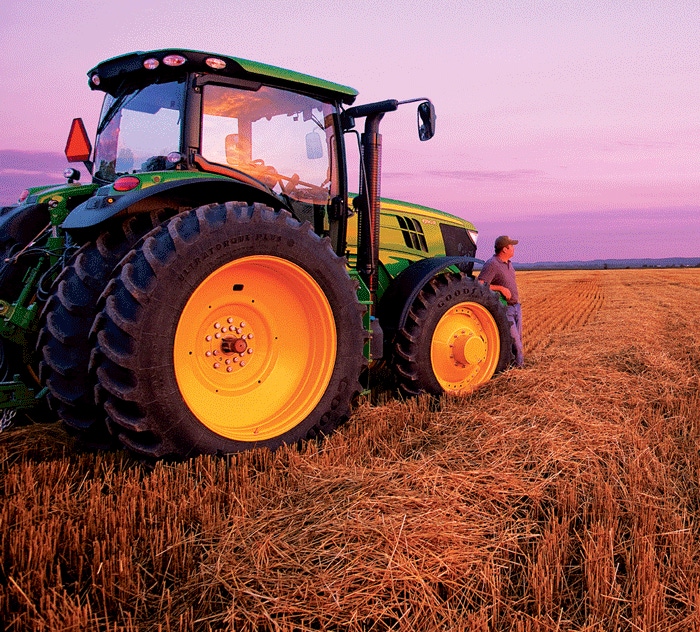
• A conservation easement is a voluntary agreement between a landowner and a land trust, a private, non-profit organization that works to conserve the land.• In this type of agreement, the landowner "gifts" the conservation easement to the land trust.• The landowner, in turn, benefits from federal income tax deductions.
December 2, 2011

Landowners who want to ensure their farmland will be farmed for generations to come can consider a conservation easement to limit its future development even if they later sell the land.
A conservation easement is a voluntary agreement between a landowner and a land trust, a private, nonprofit organization that works to conserve the land. In this type of agreement, the landowner "gifts" the conservation easement to the land trust. The landowner, in turn, benefits from federal income tax deductions.
"Granting a conservation easement means the development rights for the land have been transferred, by a deed, to an organization qualified under Section 501(c)(3) of the Internal Revenue Code, such as a land trust," said Gerry Harrison, Purdue Extension agricultural economist. "The organization holding the easement has the responsibility to see the land is not developed for anything other than the landowner's retained purposes, such as agricultural production or perhaps some limited structures such as a homestead."
In other words, the landowner maintains ownership while the land trust ensures that the terms of the conservation easement are followed. The landowners can reserve the right in the conservation easement deed to build a house or farm facilities, and, according to Harrison, they should be careful to consider those options before entering the legally binding contract.
The conservation easement remains in effect even if the land is later sold, giving assurance that the land will be used as the owner had intended.
The standard tax rule for a gifted conservation easement limits the charitable deduction to 30 percent of the donor's contribution base (adjusted gross income computed without regard to any net operating loss carry-back to the taxable year), Harrison said. Amounts not deductible in the year of the gift are carried forward and deducted for up to five years.
Still in force, at least until the end of 2011, is a 2006 federal tax amendment that greatly enhances the deduction for gifts of conservation easements. Generally, for conservation easements, the amendment permits a deduction for the charitable contribution of 50 percent of the contribution base, minus other charitable deductions on the taxpayer's Schedule A, and extends the carryover period from five to 15 years.
Example of tax considerations
Consider the example of a taxpayer who has an adjusted gross income of $100,000 and gives a $90,000 conservation easement and $10,000 of other charitable gifts. The amendment permits $40,000 ($50,000 minus $10,000) of the value of the conservation easement to be deducted in the tax year of the gift. The $50,000 balance of the conservation easement may be carried forward and deducted over a maximum of 15 years.
The amendment, however, allows farmers or ranchers to deduct 100 percent of their contribution base in a given year if they derive at least 50 percent of their income from the trade or business of farming (I.R.C. Section 2032A(e)(5).
In the above example, if the taxpayer donating the conservation easement were a farmer, he or she could deduct the entire $90,000 in the tax year of the conservation easement donation, as well as the $10,000 of other charitable gifts. If there were a higher value conservation easement, the carryover period is 15 years.
Corporations in farming and ranching that donate a conservation easement also may qualify for the 100 percent limit.
While the 2006 amendment was extended through 2011, Harrison said the extension might not continue because of ongoing government budget discussions. Even if that's the case, tax benefits still will be available under the standard rule for those gifting a conservation easement.
While gifting a conservation easement comes with tax benefits, Harrison also said there are some initial costs.
"The process of determining the value of the development rights on a parcel of land requires a professional appraisal to determine the fair market value less the agricultural value. The difference is the conservation easement," Harrison said.
There are costs for an appraisal and for a fee paid to the entity that takes the easement and promises to monitor the easement.
"These costs should be easily offset by the income tax savings from the deduction of the easement," he said.
Harrison said landowners interested in pursuing a conservation easement should consult with an accountant or tax lawyer to learn more about how the agreement will affect personal and federal tax liability and how the transfer of the development rights will reduce potential gift, estate and inheritance taxes.
More information about conservation easements is available in two free Purdue Extension publications. "Conservation Easements in Indiana" is at http://www.ces.purdue.edu/extmedia/ID/ID-231/ID-231.pdf and "Tax Treatment of Conservation Easements" is at https://mdc.itap.purdue.edu/item.asp?itemID=19448.
You May Also Like



